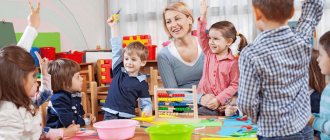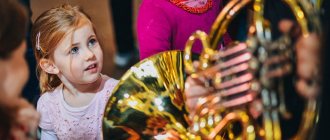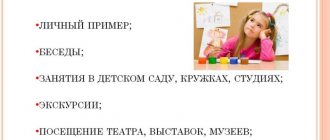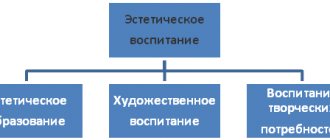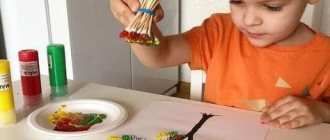CHILDHOOD GUIDE
Traditionally, artistic and aesthetic development was considered as a means of developing the expressiveness of preschoolers’ speech and activating their poetic and musical hearing. However, recently a wider range of tasks has been solved in this area: - development of the child’s creative potential; — development of imaginative, associative thinking; — development of independence and creative activity.
In accordance with the Federal State Educational Standard for preschool education, artistic and aesthetic development presupposes: - development of the prerequisites for the value-semantic perception and understanding of works of art ( verbal , musical , visual), the natural world; - the formation of an aesthetic attitude towards the surrounding world; — formation of elementary ideas about types of art; - perception of music, fiction, folklore; - stimulating empathy for characters in works of art; - implementation of independent creative activities of children (visual, constructive-model, musical, etc.).
The artistic and aesthetic development of preschool children includes: 1) the experience of the child’s emotional and moral attitude to the surrounding reality, embodied in music, fine arts and works of art; 2) experience in artistic and creative activities .
The formation of a general personal culture occurs in the process of artistic and aesthetic activity. Artistic and aesthetic activity is an activity that occurs in a child under the influence of a literary, musical work or a work of fine art.
In this regard, special attention should be paid to such a concept as “perception” . This is a mental process of conscious, personal, emotional comprehension and understanding of a work of art. The child perceives artistic images in his own way, enriches them with his own imagination, and relates them to his personal experience. One of the main tasks of a teacher in this direction is the development of emotional responsiveness . Through empathy, complicity, and “entering the image,” the foundations of the artistic and aesthetic culture of the preschooler’s personality are formed.
The content of the educational field “Artistic and Aesthetic Development” includes, inter alia, knowledge and skills in visual, constructive-model, and musical activities. A child, in accordance with his age capabilities and characteristics, should know fairy tales, songs, poems; be able to dance, design, draw.
In the section “Artistic and Aesthetic Development” you will find more detailed information in this area. for music directors - “Musical Development”.
Dear teachers! If you have questions about the topic of the article or have difficulties in working in this area, then write in the comments . I'll definitely help.
Golovina Bela Gennadievna, site administrator.
Topics on self-education: artistic and aesthetic development of preschoolers Artistic and aesthetic development of preschoolers through creative projects Artistic and aesthetic development of preschoolers in the process of manual labor Federal State Educational Standard for Education: musical development >
Artistic and aesthetic development of children in the context of the implementation of the Federal State Educational Standard in preschool educational institutions
Nina Trufanova
Artistic and aesthetic development of children in the context of the implementation of the Federal State Educational Standard in preschool educational institutions
Artistic and aesthetic development of preschool children includes:
— the experience of a child’s emotional and moral attitude to the surrounding reality, embodied in music, fine arts and works of art ;
— experience in artistic and creative activities .
The formation of a general personal culture occurs in the process of artistic and aesthetic activity .
Artistic and aesthetic activity is an activity that occurs in a child under the influence of a literary, musical work or a work of fine art.
In this regard, special attention should be paid to such a concept as “perception”
.
This is a mental process of conscious, personal, emotional comprehension and understanding of a work of art. artistic images in his own way , enriches them with his own imagination, and relates them to his personal experience.
One of the main tasks of a teacher in this direction is the development of emotional responsiveness. Through empathy, complicity, “getting into character”
the artistic and aesthetic are being formed .
Contents of the educational field “ Artistic and aesthetic development ”
includes, among other things, knowledge and skills in visual, constructive-model, and musical activities. A child, in accordance with his age capabilities and characteristics, should know fairy tales, songs, poems; be able to dance, design, draw.
One of the most important conditions for the implementation of the system of artistic and aesthetic development in a preschool institution is the organization of a developing subject-spatial environment. When creating a subject-spatial environment, the educator must be guided by the general principles defined in paragraph 3.3. 4 Federal State for preschool education. A developing subject-spatial environment must be content-rich, transformable, semi-functional, variable, accessible and safe.
In each age group, conditions must be created for artistic, speech , visual and musical activities: book corners, theatrical, visual, and musical activities.
At the same time, they must be equipped so that children can freely approach the corner and choose any material for creativity, showing independence and initiative.
Corners and employment centers should contain a variety of materials, manuals, and games.
In the corners of the books you need to place:
children's fiction and encyclopedic literature in accordance with age,
themed albums,
homemade books,
portraits of writers,
selections of audio and video recordings of fairy tales, stories, poems.
In order to constantly maintain children's interest in books , it is necessary to regularly organize exhibitions of one author, one direction or theme (writers about animals, fairy tales of the Brothers Grimm, poems by S. Ya. Marshak, etc.).
"talking books"
In the corners of theatrical activity...
Different types of theater: tabletop, flannelgraph, shadow, finger, etc.
screen;
sets of puppets (finger and flat figures, puppets)
for acting out fairy tales;
theater made by the children and teachers themselves (cones with heads, various masks, decorations)
;
characters with different moods;
material for making characters and decorations (colored paper, glue, waste material, pencils, paints, scissors and other materials);
ready-made costumes, masks for acting out fairy tales, homemade costumes;
substitute attributes (circles of different colors, stripes of different lengths)
to designate magical objects and mark out the play space in kindergarten;
mummers corner
In the corners of fine art...
-works of folk art: folk clay toys (Filimonovsky, Dymkovsky, Kargopol, etc.)
toys made of wood (Bogorodsky, Smenevsky, etc.
Visual and didactic aids
Paintings: still life, landscape, portrait
Paper of different formats, different shapes, different tones.
A sufficient number of colored pencils, paints, brushes, rags, plasticine (stacks, modeling boards)
Availability of colored paper and cardboard
A sufficient number of scissors with rounded ends, glue, oilcloths, rags, napkins for applique
Waste material (foil, candy wrappers, etc.)
A place for rotating exhibitions of children's works, joint works of children and parents
Space for rotating exhibitions of works of art
Coloring albums
Sets of postcards, pictures, books and albums with illustrations, subject pictures
In the corners of musical activity...
Children's musical instruments
Record player
In audio recordings: children's songs, fragments of classical music and folklore works, lullabies, recordings of nature sounds
Albums with drawings or photographs of musical instruments.
Pictures for songs performed in music classes
Electric musical toys with sets of melodies
Sound books and postcards
Musical toys (voiced, unvoiced)
Musical and educational games
Musical and didactic aids
All this contributes to the emancipation of children and a positive emotional mood for the whole day.
The subject-development created in kindergarten should promote cognitive development , the development of interest in the world of art, skills in visual, musical, theatrical activities, and creativity.
The main component of the system of work on artistic and aesthetic development is the organization of the educational process.
Educational work on the artistic and aesthetic development of children in preschool educational institutions should be carried out simultaneously in several directions:
• Interaction between teachers and children
• Interaction with families
• Cooperation with institutions of the social and pedagogical environment
Interaction between teachers and children is carried out through the following forms of work:
— GED (direct educational activities)
.These are classes in the aesthetic cycle: artistic activities, music, and familiarization with
fiction . But, most importantly, it is necessary to organize work with an artistic and aesthetic orientation in all types of classes (integration of educational areas)
.
This is the inclusion of artistic expression , musical accompaniment, demonstration of illustrations, dramatization, etc....
— Organized educational activities for adults and children (holidays, entertainment , themed musical evenings, theatrical performances, didactic games, exhibitions of drawings and crafts, etc.)
— Independent children’s activities aimed at strengthening interest in artistic activities and developing creative abilities (games, concerts, performances, productive activities)
.
In order for independent activity to unfold conditions : a rich subject environment, the development of skills and abilities, motivation...
The knowledge gained in the course of direct educational organized activities of the aesthetic cycle is reflected in the play activities of students. They enjoy playing music, showing mini-performances, dancing, retelling fairy tales, doing their own writing, drawing, and creating collective creative works.
The organization of various forms of work with children is reflected in the results: children show interest and creativity in visual, musical, artistic speech , and theatrical activities; participate in exhibitions and competitions.
Theatrical activities provide a rich field for the aesthetic development of children , as well as the development It represents an organic synthesis of fiction , music, dance, painting, acting and concentrates the means of expression available in the arsenal of individual arts.
To achieve the full development and upbringing of a preschool child, it is necessary to coordinate the efforts of the preschool institution and the family in which he is being raised. Despite the fact that the child spends most of his time in kindergarten, the family remains the most important social institution that has a decisive influence on the development of the preschooler’s personality.
Cooperation with the family can be built in the following areas:
1. Improving the psychological and pedagogical culture of parents, which is carried out through:
parent meetings and conferences,
group and individual consultations,
open days,
workshops,
folders – transfers and information sheets for parents,
thematic exhibitions, publications in the media….
2. Involvement of the family in the educational process organized by the preschool institution:
participation in the educational process (they talk about their professions, hobbies, show different ways of working with different materials, etc.,
participation in the implementation of projects ,
organizing joint activities of children and adults to publish family newspapers in order to enrich the communicative experience of preschoolers
participation in competitions, holidays, exhibitions of drawings and crafts, etc.
participation in theatrical performances...
joint organization of exhibitions of works of art (decorative and applied arts)
in order to enrich
the artistic and aesthetic ideas of children
3. Assistance in creating material and technical conditions :
assistance in designing a development environment ,
assistance in making scenery and sewing costumes,
organizing joint gatherings, visits to museums, art exhibitions .
All this helps to make parents their allies and like-minded people in raising children .
Also, the effectiveness of work on artistic and aesthetic development depends on the coordination of work with other institutions: school, museum, music school, library, art school ) mutual visits to performances between preschoolers and schoolchildren, musical themed evenings, joint exhibitions, holidays, quizzes, literary lounges are held , excursions, master classes.
All participants in the pedagogical process are located and live in a certain society, which affects children , teachers, and parents.
And finally, the effectiveness of artistic and aesthetic development is largely determined by the interaction of all pedagogical workers of the preschool educational institution (teacher, music director, senior teacher, specialists (psychologist, speech therapist, physical education instructor)
.
Each employee assumes certain functional responsibilities in the field of artistic and aesthetic development .
Each specialist, acting in his own direction, works towards a common goal, fulfilling state standards of preschool education.
Artistic and creative activities of preschool children
Publications on the topic:
Artistic and creative activities of children dedicated to the 70th anniversary of Victory in the Great Patriotic War. As I promised in the previous publication, I bring to your attention our crafts for the Great Victory Day, which the children and I completed.
Artistic and creative activity of children of the second younger group - application “Eternal Memory of Heroes” Goal: to cultivate in children a feeling of deep gratitude to the great feat of their grandfathers and great-grandfathers, who gave their descendants victory in the Great Patriotic War.
Artistic and creative activity. Summary of GCD in the second junior group (modeling) “Candy for Friends” Tasks: 1. Learn to pinch off small lumps of plasticine, roll them between your palms with straight movements, sculpt only on the board. Develop.
Artistic and creative activity using plasticine "Bunches of Rowan" The children of my group love to sculpt. They create simple shapes with great interest. I have long been interested in non-traditional techniques in artistic creativity.
Artistic and creative activities with middle-aged children. Application “Let's go to the forest to pick mushrooms” Purpose: to develop cognitive and creative perception of nature. Tasks:1. teach children to cut an oval from a rectangle. 2. Teach children to cut.
Artistic and creative activities with middle-aged children. Modeling “Fruit Harvest” Purpose: to develop children’s aesthetic perception of nature and teach them to convey the image of fruits through plasticineography. Tasks:1. Learn.
Artistic and creative activities with middle group children. Application with drawing elements “Sparrows” Purpose: to cultivate a kind, caring attitude towards birds; continue to develop the ability to hold and use scissors; learn to cut.
Artistic and creative activities with middle group children. Application “Funny frogs” Topic: “Funny frogs”. Goal: develop creative imagination; continue to develop the ability to hold scissors correctly and use them;
Artistic and creative activity of a teacher with children of the middle group. Modeling "Let's decorate the Christmas tree for the holiday." Artistic and creative activity of a teacher with children of the middle group. Modeling "Let's decorate the Christmas tree for the holiday." Completed by a GBDOU teacher.
Creative composition in the motor activity of children of senior preschool age. Dashing sailors Goal: To develop imagination, clarity and expressiveness of actions, speed of reactions in various motor tasks. Equipment: Flags for everyone.

